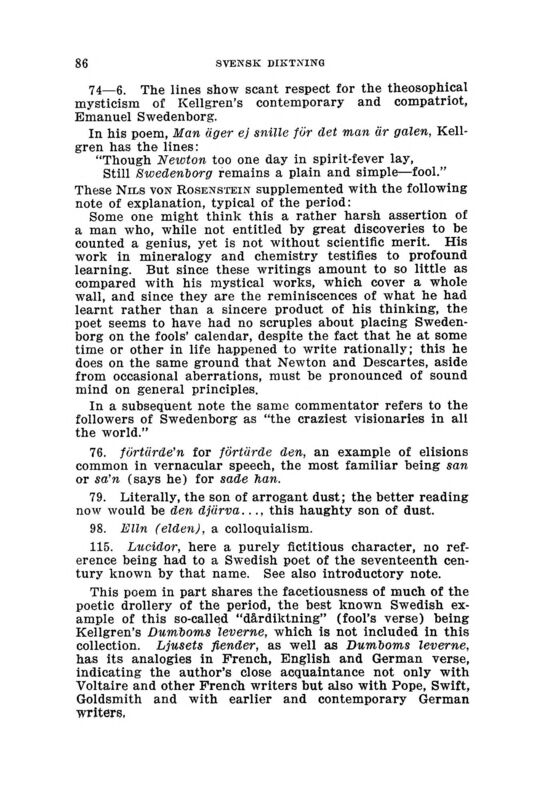
Full resolution (JPEG) - On this page / på denna sida - Sidor ...

<< prev. page << föreg. sida << >> nästa sida >> next page >>
Below is the raw OCR text
from the above scanned image.
Do you see an error? Proofread the page now!
Här nedan syns maskintolkade texten från faksimilbilden ovan.
Ser du något fel? Korrekturläs sidan nu!
This page has never been proofread. / Denna sida har aldrig korrekturlästs.
86 SVENSK DIKTNING
74—6. The lines show scant respect for the theosophical
mysticism of Kellgren’s contemporary and compatriot,
Emanuel Swedenborg.
In his poem, Man äger ej snille för det man är galen,
Kellgren has the lines:
«Though Newton too one day in spirit-fever lay,
Still Swedenborg remains a plain and simple—fool.”
These NILS VON ROSENSTEIN supplemented with the following
note of explanation, typical of the period:
Some one might think this a rather harsh assertion of
a man who, while not entitled by great discoveries to be
counted a genius, yet is not without scientific merit. His
work in mineralogy and chemistry testifies to profound
learning. But since these writings amount to so little as
compared with his mystical works, which cover a whole
wall, and since they are the reminiscences of what he had
learnt rather than a sincere product of his thinking, the
poet seems to have had no scruples about placing
Swedenborg on the fools” calendar, despite the fact that he at some
time or other in life happened to write rationally; this he
does on the same ground that Newton and Descartes, aside
from occasional aberrations, must be pronounced of sound
mind on general principles.
In a subsequent note the same commentator refers to the
followers of Swedenborg as "the craziest visionaries in all
the world.”
76. förtärde’n for förtärde den, an example of elisions
common in vernacular speech, the most familiar being san
or sån (says he) for sade han.
79. Literally, the son of arrogant dust; the better reading
now would be den djärva. .., this haughty son of dust.
98. Elin (elden), a colloquialism.
115. Lucidor, here a purely fiectitious character, no
reference being had to a Swedish poet of the seventeenth
century known by that name. See also introductory note.
This poem in part shares the facetiousness of much of the
poetic drollery of the period, the best known Swedish
example of this so-called "dårdiktning” (fool’s verse) being
Kellgren’s Dumboms leverne, which is not included in this
collection. Ljusets fiender, as well as Dumboms leverne,
has its analogies in French, English and German verse,
indicating the author’s close acquaintance not only with
Voltaire and other French writers but also with Pope, Swift,
Goldsmith and with earlier and contemporary German
writers,
<< prev. page << föreg. sida << >> nästa sida >> next page >>